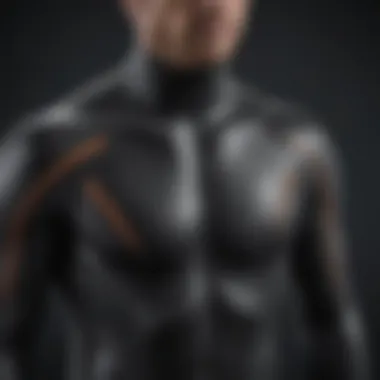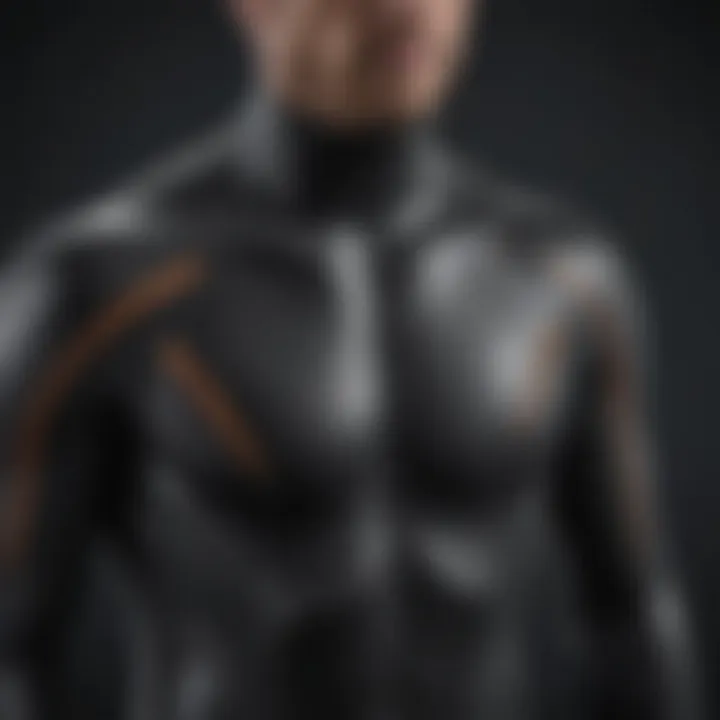Your Ultimate Guide to REI Wetsuits for Surfing


Intro
When you think of surfing, there's more to it than just catching a wave and riding it to shore. A crucial element that can enhance your experience greatly is the wetsuit. For those who are surfing aficionados, including instructors, lifeguards, and enthusiasts, understanding the intricacies of REI wetsuits is paramount.
REI, renowned for its commitment to outdoor enthusiasts, produces wetsuits that merge advanced design with functionality. Whether you're paddling out in cooler waters or looking to stay protected from the sun's harsh rays, the right wetsuit can make all the difference.
In this guide, we will peel back the layers on REI wetsuits, diving into both the anatomical elements of their design and the material science involved. Surfers can find insights into choosing a wetsuit tailored for different surfing conditions. Moreover, we will cover the importance of maintenance and care—not just for the wetsuits but also for the environment through sustainable practices in wetsuit production.
By the end of this deep dive, you'll be equipped with knowledge that makes you not just a smarter surfer, but also an eco-conscious one who values sustainability. Let’s get started!
Preamble to Wetsuits
In the world of surfing, where nature rules the game and conditions can turn on a dime, wetsuits are nothing short of revolutionary. They are the bridge between comfort and performance, granting surfers the ability to revel in the ocean's embrace, regardless of the temperature. This section will peel back the layers on what wetsuits are designed for, their historical evolution, and why they’ve become an essential piece of gear for everyone from weekend warriors to seasoned pros.
The Purpose of Wetsuits
At its core, the primary purpose of a wetsuit is to provide thermal insulation while maintaining flexibility. The very mechanism of a wetsuit lies in its construction and material; generally made from a synthetic rubber known as neoprene, wetsuits trap a thin layer of water between the suit and the body. This water warms up quickly from body heat, creating a barrier against the chill of the ocean as well as shielding surfers from wind and waves. Without it, conquering cold waters would be much like trying to catch a wave in a freezer—nigh impossible.
Wetsuits also serve as protection against abrasions, stings, and in some cases, jellyfish encounters. Their snug fit helps reduce the risk of rashes that can stem from long hours spent bobbing in saltwater. In varying thicknesses, wetsuits cater to different environments, allowing surfers to paddle out in conditions that would normally be too uncomfortable or even dangerous. Whether you're riding the gentle waves of a warm summer day or braving the teeth of winter swells, there's a wetsuit suited just for you.
Here are some key benefits:
- Thermal protection against cold conditions.
- Buoyancy that aids in keeping you afloat.
- Skin protection from potential stings and scrapes.
Ultimately, wetsuits play a crucial role in maximizing comfort and safety in water activities, allowing surfers to stay in the water longer while improving their overall experience.
A Brief History of Wetsuits
To understand the significance of the wetsuit today, we must trek back to when these garments were first conceived. The early days of surfing, particularly in the mid-20th century, saw surfers braving the elements often with little more than board shorts or cotton t-shirts. But as surf culture began to thrive, so did the necessity for something better—something that could provide warmth and comfort.
The first wetsuits were famously produced in the 1950s by Jack O'Neill, who sought to extend his time spent surfing in the chilly waters of California. His innovation came with the invention of a more flexible and durable neoprene material that revolutionized water sports. From that point on, wetsuits evolved quickly, with various designs and thicknesses tailored to specific water temperatures and activities.
The evolution didn't stop there. As surfers became more discerning about performance, wetsuits started to incorporate advanced features like reinforced seams, ergonomic cuts, and even stylish designs that reflect personal flair. Today’s wetsuits are a far cry from their humble beginnings, often featuring high-tech materials and construction methods designed to enhance both performance and sustainability.
Understanding the purpose and development of wetsuits sets the stage for appreciating the depth of choices, experiences, and technical innovations present in products on the market today, especially those offered by REI. By recognizing the roots of this essential surfing gear, enthusiasts gain insight into how far we've come—and just how pivotal the right wetsuit can be to that perfect ride.
Overview of REI Wetsuits
Understanding the diverse range of REI wetsuits is crucial for any surfing enthusiast looking to enhance their experience on the water. This section pivots around the key elements of the products that REI offers, emphasizing their quality, innovation, and the specific needs they meet for various water conditions. REI has carved a niche in the outdoor apparel segment, stoking a commitment to environment-friendly practices while ensuring performance. This balance of durability and sustainability makes their wetsuits a pertinent choice for conscientious surfers.
REI Brand Philosophy
The philosophies underpinning the REI brand are centered on a commitment to the outdoors and a strong advocacy for sustainable practices. Founded in 1938 by a group of avid climbers, REI has always championed quality gear that can withstand the rigors of outdoor adventures. This ethos translates into their wetsuit designs, which cater to surfers who desire both performance and environmental responsibility. They focus on utilizing materials and manufacturing processes that have minimal impact on our planet. This alignment with eco-conscious values is significant, especially in an era where consumers are increasingly making purchasing decisions based on sustainability.
Types of REI Wetsuits
When it comes to REI wetsuits, understanding the different types available is essential. Each type serves specific needs and conditions, ensuring surfers can find something that fits perfectly with their preferences and the demands of the environment.
Full Suits


Full suits are widely regarded as a staple for many surfers, particularly in colder waters. One key characteristic of full suits is their long sleeves and legs, which provide comprehensive coverage and insulation. They are especially beneficial in maintaining body temperature, which is crucial for extended sessions in the chilly waves. One standout feature is the use of varying thicknesses of neoprene in different areas, allowing for better flexibility around joints while still delivering warmth. This balance of thermal retention and mobility makes full suits an ideal choice for serious surfers looking to push themselves, no matter the temperature.
Shorty Suits
Shorty suits, also known as spring suits, are a different kettle of fish. They typically have short sleeves and legs, making them a favored option for warmer waters. The primary advantage of shorty suits lies in their breathability and ease of movement. Surfers often reach for these suits during the late spring to early summer months, when water temperatures begin to rise but a full wetsuit may feel excessive. However, surfers should consider that while shorty suits are great for warmer weather, they lack the same thermal protection offered by full suits.
Spring Suits
Spring suits can be viewed as a hybrid option, straddling the line between full and shorty suits. Designed for early spring or late summer sessions, they offer more coverage than a shorty without the full enclosing nature of a full suit. One defining characteristic is the optional added thickness in key areas like the chest, where surfers need more warmth without compromising on mobility. They come with the respect of being a versatile pick for those who surf in fluctuating temperatures, but it’s worth noting that they may not provide sufficient insulation for very cold waters.
Accessories
Accessories play a vital role in augmenting the overall surfing experience, particularly when paired with wetsuits. Items such as booties, hoods, and gloves enhance warmth and protection in very cold conditions. The ability to mix and match these accessories with different types of wetsuits amplifies comfort and performance. For instance, wearing booties with a full suit allows surfers to extend their sessions even further into the colder months. However, it’s essential for surfers to choose accessories that fit well, as improper fitting can lead to discomfort and reduced effectiveness.
"Investing in the right wetsuit and accessories can mean the difference between a memorable surf day and one that's soaked with regrets."
In summary, each type of REI wetsuit offers unique advantages suited to varying surfing conditions and personal preferences. Whether braving the frigid surf with a full suit or enjoying the warmth of summer in a shorty suit, REI covers the spectrum with their high-quality options.
The Science of Wetsuit Materials
When it comes to surfing, selecting the right wetsuit materials can be a game-changer. It's not just about comfort on those winter waves or finding something that fits snugly; the materials choose can profoundly affect your performance and enjoyment in the water. How well a wetsuit insulates, its durability against wear and tear, and even its environmental impact hinge on the science of its construction.
Neoprene: The Material of Choice
Historically, neoprene has been the go-to for surf suits, and for good reason. Its closed-cell structure traps tiny air bubbles, acting like a cozy blanket that keeps you warm even in chilly waters. This insulation is crucial during rigorous activities, where your body temperature can vary greatly. Furthermore, neoprene's flexibility allows for easy movement, crucial when you're paddling out or catching a wave.
And let's not forget durability. Neoprene holds up against the ocean’s harsh elements, resisting saltwater, sunlight, and general wear. There’s a slight downside, though: neoprene isn't exactly the most eco-friendly choice. Many brands have been working hard to improve this aspect, but it's still something to keep in mind.
While there are alternatives, neoprene remains a staple in the wetsuit game because it’s dependable and has been fine-tuned over decades. However, understanding the material itself will surely help you appreciate its place in the lineup.
Eco-friendly Alternatives
In recent years, there's been a noticeable shift toward more sustainable materials in wetsuit manufacturing. As surfers become more conscious about the environment, manufacturers are rising to the occasion. For example, some brands are now offering suits made from Yulex, a natural rubber derived from rubber trees. This option not only provides comparable warmth and flexibility to neoprene but holds a much lower carbon footprint.
Another innovative material comes from recycled plastics. This might sound like a stretch—recycling plastics into something you wear while surfing—but it’s true. By upcycling materials that would otherwise pollute our oceans, brands are making strides toward a more sustainable future.
As surfers, making choices that reflect a commitment to the environment is essential. So, while neoprene remains in the spotlight for its performance, it's the eco-friendly alternatives that help keep the oceans clean and the waves enjoyable. You’ll be glad to know that a variety of options are out there now to consider.
"Choosing the right wetsuit material can significantly affect not only your performance but also your environmental footprint as a surfer. "
As you’re navigating the world of wetsuits, this understanding of materials can sharpen your decision-making. It’s more than just looking for the right fit; it’s about considering how each material serves your needs and protects the oceans you love.
Key Features of REI Wetsuits
When it comes to surfing, the right wetsuit can be a game changer. A wetsuit isn’t just a garment; it’s an essential tool that provides both warmth and protection while you're in the water. This section delves into Key Features of REI Wetsuits pertinent to surfers, addressing vital elements such as sizing, thermal insulation, and construction. Each aspect is critical to making the surfing experience enjoyable, safe, and effective.
Sizing and Fit
Sizing and fit are foundational to the performance of any wetsuit, including those from REI. A poorly fitting wetsuit can turn a great surf session into a chilly and uncomfortable affair. Surfers should consider that wetsuits should be snug, yet flexible enough to allow for movement.
Most REI wetsuits come in a range of sizes, from small to extra-large, accommodating various body shapes. Here are a few key points:
- Snug but Comfortable: The wetsuit should hug your body without constricting movement. Over time, a loose suit can lead to water pooling inside, causing you to lose heat rapidly.
- Try before you buy: If possible, trying on a wetsuit is vital. What feels right in the store can feel very different in the ocean, especially when you consider the natural buoyancy of the material in water.
- Consider adjustments: Some suits provide extra features like adjustable necklines or ankle seals that can tailor the fit further, minimizing the entry of cold water.


Thermal Insulation
Thermal insulation is what keeps you warm in cooler waters. Not all wetsuits feature the same level of insulation, and that’s where REI’s selection shines. They utilize various thicknesses of neoprene and innovative materials that enhance insulation.
- Thickness matters: Generally, wetsuits are rated by their thickness in millimeters. For cold waters, look for suits that are 4mm or thicker, while warmer conditions can often be addressed with a lighter 2mm or 3mm suit.
- Heat retention technology: Many REI wetsuits incorporate innovative lining that reflects body heat, contributing to overall warmth without adding bulk. This allows for flexibility while keeping heat retention a priority.
"Choosing the correct wetsuit thickness based on your local water temperature will enhance your surfing experience immensely."
Seams and Construction
The construction of a wetsuit is equally important as the materials and thickness. The seams are where many suits can falter, so knowing how they’re constructed is key to longevity and performance.
- Seam types: REI wetsuits typically feature flatlock, glued, and blind stitched seams. Each type offers varying levels of durability and water resistance. Blind-stitched seams, for example, are known for being less prone to leaking because they’re not punched through the material.
- Quality control: REI is known for its high manufacturing standards. Checking for the quality of stitching and the integrity of glued areas can save you headaches later. Properly constructed seams can significantly enhance the lifespan of your wetsuit.
Choosing the Right REI Wetsuit
Finding the right wetsuit isn’t just about brand or style; it’s a matter of comfort and functionality that can make or break your surfing experience. Choosing the right REI wetsuit ensures you’re well-prepared for varying conditions, allowing you to enjoy every wave without worrying about cold or discomfort. Each surfer's needs can differ significantly based on several factors, from water conditions to personal preferences. Here’s a closer look at the considerations that can guide your decision.
Assessing Water Temperature
Water temperature plays an essential role in the decision-making process. Surfers need to be mindful of not just how it feels on the first dip but also how long they plan to stay in.
- Warm Water: If the temperature hovers around 70°F or above, a shorty suit or even a sleeveless option might suffice. These thinner suits allow for greater freedom of movement, ideal for those intense, action-packed days.
- Cooler Waters: For temperatures between 60°F and 70°F, a full suit often comes into play, typically 2mm to 3mm thick. This thickness provides enough insulation without being bulky.
- Cold Conditions: When water temperatures dip below 60°F, consider a thicker wetsuit, around 4mm or more. Make sure it has adequate thermal insulation to keep your body warm amidst chilling waves.
This aspect, while straightforward, can deeply influence your performance. Wearing the wrong suit can lead to discomfort and fatigue, so take time to gauge the waters before making a purchase.
Activity Level Considerations
Your level of activity while surfing also directs your choice. The more rigorous your surfing is, the more features you might need in your wetsuit.
- Leisurely Surfing: If you plan on casual paddling or occasional small wave rides, a standard wetsuit with decent insulation is usually enough.
- Intensive Surfing: For surfers pushing through powerful waves or those that tend to stay in the water for extended periods, look for wetsuits that incorporate advanced materials such as thermal linings or quick-dry properties. These features can help maintain your warmth without feeling like a lifeboat.
- Specialized Conditions: If you’re heading to a surfing competition or tackling big waves, prioritize wetsuits that offer advanced flexibility and durability, as you’ll need to perform your best under pressure.
In essence, consider your surfing style—this will heavily influence not just comfort, but also your overall experience in the water.
Budgetary Factors
While budget plays a pivotal role in any purchase, it’s about balancing cost with quality. Investing in a top-notch wetsuit can be the difference between being adequately protected and feeling like you’ve just jumped into an ice bath.
- Entry-Level Options: For beginners or those who surf occasionally, there are plenty of affordable options available at REI without compromising quality. You might find suits starting from around $100 that should keep you warm during short sessions.
- Mid-Range Choices: As you become more serious about surfing, investing between $200 to $400 can yield wetsuits with better materials and features such as enhanced flexibility and warmth.
- Premium Wetsuits: For dedicated surfers who battle harsh conditions or for those needing the latest technology, prices can soar over $500. These wetsuits often use proprietary materials designed to withstand cold and wear more effectively while maintaining durability.
Ultimately, the goal is to find a balance that meets your budget constraints while catering to your surfing needs. It’s better to save a bit for a better quality suit than to scrimp and end up with something that leaves you shivering on the beach.
The right wetsuit can amplify your surfing experience, allowing you to focus on enjoying the waves instead of dealing with discomfort.
By carefully considering water temperature, your activity levels, and your budget, you can effectively navigate the wide world of REI wetsuits, ensuring you make a choice that is both practical and enhancing to your surfing journey.
Caring for Your REI Wetsuit
Maintaining your REI wetsuit is paramount if you intend to get the most out of your investment. These suits are not just gear; they’re a vital component of your surfing experience. Proper care prolongs their lifespan, ensuring they perform optimally in various water conditions. With that in mind, let's delve into the specifics of how you can keep your wetsuit in tip-top shape.


Cleaning and Drying
Cleaning a wetsuit might not be the most glamorous task, but it’s essential for keeping it functional and fresh. After each surf session, it’s advisable to rinse your wetsuit inside out with fresh water to remove salt, sand, and other debris. Salt can degrade the neoprene over time, while sand can create micro-abrasions that lead to wear.
Here’s how to clean your wetsuit effectively:
- Rinse: Use lukewarm water, as high temperatures can break down the neoprene. Ensure you get into every nook and cranny.
- Soak: Consider using a wetsuit cleaner, which is specifically designed for these materials. Follow the instructions for soaking time.
- Dry: Hang the wetsuit to dry in a shady area, preferably on a wide hanger, to maintain its shape. Avoid direct sunlight since it can lead to fading and material damage.
After you’re done cleaning, it’s tempting to just throw it in the garage, but drying is where things can go pear-shaped. Do not wrap your wetsuit tightly or leave it crumpled in a bag. Letting it dry properly helps prevent mold from taking root, which can lead to unpleasant odors.
"Proper care extends the life of your wetsuit by years, not months. Treat it well, and it’ll treat you well."
Storage Tips
Where and how you store your wetsuit can greatly influence its longevity. A good storage routine involves:
- Cool, Dry Place: Keep your wetsuit in a well-ventilated area that's away from direct sunlight. Sunlight can deteriorate the materials and lead to unwanted stiffness.
- Avoid Weight: Do not place heavy items on your wetsuit or fold it in a way that creates heavy creases.
- Use Hangers: A broad hanger is ideal to prevent stretching around the shoulders. Alternatively, you may want to roll it up gently and store it flat if space permits.
By adopting mindful cleaning and storage practices, your REI wetsuit will not only prolong its lifespan but also ensure you always have a reliable piece of equipment ready to tackle the waves. This meticulous attention to care will pay dividends when caught in those chilly waters, allowing you to perform at your best.
Sustainability in Wetsuit Manufacturing
In today's world, where environmental concerns are at the forefront, sustainability in wetsuit manufacturing has become a hot topic. Surfing enthusiasts are not just seeking functionality in their wetsuits; they’re also increasingly conscious of the environmental footprint their choices leave behind. This section unequivocally connects the dots between high-performance gear and the pressing need to protect our oceans.
Environmental Impact
Wetsuits are often made from materials like neoprene, which is derived from petroleum. The production process of neoprene releases harmful chemicals, polluting air and water. Furthermore, many wetsuits end up in landfills once they have served their purpose, contributing to the growing problem of waste. Unfortunately, traditional manufacturing practices do little to mitigate these effects.
The impact doesn’t just stop at production. From renewable resource depletion to carbon emissions, the environmental toll is significant.
- Carbon Footprint: The energy used in neoprene production and transportation can lead to a sizeable carbon footprint.
- Toxic Waste: Many chemical processes involved in wetsuit manufacturing generate toxic byproducts that can leach into waterways.
To draw attention to these issues, it's essential to engage with sustainable practices in wetsuit manufacturing. By making more mindful choices, surfers can help steer the industry toward a more eco-friendly future.
"Every wave we ride should echo our commitment to protecting the oceans we love."
REI's Sustainable Practices
In response to the environmental challenges, REI has taken notable steps in promoting sustainability within its wetsuit line. Their efforts can be broken down into a couple of primary initiatives:
- Eco-friendly Materials: REI is committed to using alternatives to traditional neoprene. They explore options made from natural rubber and other sustainable materials, significantly reducing their reliance on petroleum-based products.
- Closed-loop Systems: The brand is also looking into closed-loop systems, which aim to recycle old wetsuits into new products. This approach has the potential to cut waste dramatically.
- Transparency: REI publishes information about the environmental impacts of their products, fostering transparency. This empowers consumers to make informed choices and hold brands accountable.
- Community Engagement: By hosting beach clean-up events and educational programs, REI cultivates a community of surfers who understand the significance of sustainability.
Through these measures, REI not only produces functional wetsuits but also aligns its business model with the principles of preserving the environment. None of these changes happen overnight, but the path to sustainability is paved with these deliberate actions. As surfing enthusiasts, consumers can support such practices and challenge others to follow suit.
Epilogue
In wrapping up this comprehensive exploration of REI wetsuits, it's essential to grasp the broader implications of what these suits represent for surfing enthusiasts. The modern surfer's experience is intertwined not just with the waves they ride but also with the tools they use. Wetsuits are critical in ensuring that surfers not only maximize their performance but also enjoy their time in the water, regardless of the weather or water conditions.
Final Thoughts on REI Wetsuits
When considering REI wetsuits, it's vital to recognize several key elements:
- Technology and Materials: The evolution of wetsuit materials, particularly innovations in neoprene and eco-friendly alternatives, showcases a commitment to enhancing user experience while being mindful of the environment. Surfers can find protective suits that keep them warm without compromising mobility.
- Fit and Comfort: The importance of a well-fitted wetsuit cannot be overstated. Ill-fitting wetsuits can lead to discomfort, restricting movement and ultimately impacting performance. REI’s design philosophy emphasizes tailoring suits that meet various body types, ensuring surfers can focus fully on their ride.
- Sustainability Practices: As the conversation around eco-friendliness continues to gain momentum, it becomes clear that selecting a wetsuit involves more than just performance considerations. Choosing REI, known for sustainable practices, allows surfers to invest in gear that aligns with their values, supporting a healthier planet.
"The ocean is not just a playground; it’s also a provider. Wearing a wetsuit that respects this balance is a conscious choice many surfers are now making."















